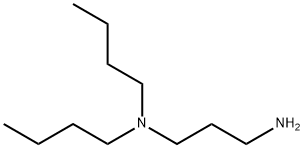Dibutylaminopropylamine

Product Description
Dibutylaminopropylamine (DBAPA) is a chemical compound used in a variety of industrial and chemical applications. It is known for its role as a catalyst, intermediate, and additive in different chemical reactions and products.
Product:
Dibutylaminopropylamine
CAS:
102-83-0
Synonym:
N,N-Dibutyl-1,3-propanediamine
Structure:

Typical Characteristics
Appearance
Colorless liquid
Boiling point
205 °C
Density
0.827 g/cm3
Molecular Weight
186.34
Purity
98%
Refractive index
1.4463
Uses, Applications & Markets
Key applications
get a quote
We Offer Dibutylaminopropylamine
in various grades
A few of the grades available are listed below:



Dibutylaminopropylamine used in many
industry applications
Dibutylaminopropylamine, also known as N,N-dibutyl-1,3-propanediamine, is an organic compound used in various industrial and chemical applications due to its properties as a catalyst, intermediate, and surfactant. Here are some of its key applications:
- Catalyst in Epoxy Curing: Dibutylaminopropylamine serves as an effective catalyst in the curing process of epoxy resins. Its basic nature accelerates the reaction between epoxy resin and curing agent, leading to faster curing times and improved mechanical properties of the final product. This is particularly beneficial in coatings, adhesives, and composite materials where performance and durability are critical.
- Intermediate in Chemical Synthesis: It acts as an intermediate in the synthesis of various organic compounds, including pharmaceuticals, agrochemicals, and dyes. Its reactivity with acids, aldehydes, and ketones makes it a versatile building block for producing a wide range of functionalized derivatives with specific chemical and biological properties.
- Surfactant and Emulsifier: Due to its amphiphilic nature, dibutylaminopropylamine can act as a surfactant or emulsifier in formulations such as cosmetics, personal care products, and industrial cleaners. It helps in reducing surface tension, improving the mixing of oil and water phases, and stabilizing emulsions, leading to enhanced texture, spreadability, and stability of the products.
- Corrosion Inhibitor: It is employed as a corrosion inhibitor in metalworking fluids, cooling systems, and oilfield applications. The amine groups in dibutylaminopropylamine can adsorb onto metal surfaces, forming a protective layer that minimizes corrosion caused by water, oxygen, and other corrosive agents. This extends the lifespan of metal components and infrastructure.
- Flocculant in Water Treatment: In water treatment processes, dibutylaminopropylamine can be used as a flocculant to aggregate suspended particles, facilitating their removal from water. It is effective in clarifying water, treating industrial effluents, and processing waste streams, contributing to cleaner water and environmental protection.
- Personal Care Products: Its mild basicity and surfactant properties make dibutylaminopropylamine suitable for use in personal care products, including hair conditioners, skin creams, and lotions. It can improve product performance by adjusting pH, enhancing conditioning effects, and promoting emulsion stability.
- Textile and Leather Processing: In the textile and leather industries, dibutylaminopropylamine is utilized as a processing aid to improve dye uptake, enhance softness, and impart desired finishes to fabrics and leather goods. It can function as a softening agent, dyeing assistant, or pH regulator, contributing to the quality and aesthetics of the final products.